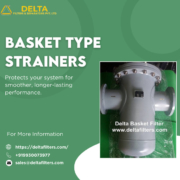Enhancing Industrial Process Efficiency Through Advanced Filtration Solutions
Industrial filtration and separation systems form the backbone of reliable operations across numerous sectors, from oil and gas processing to chemical manufacturing and pharmaceutical production. Two critical components that significantly impact system performance and equipment longevity are basket type strainers and demister pads. These engineered solutions address distinct challenges in maintaining fluid purity and protecting valuable downstream equipment from costly damage.
The Role of Basket Type Strainers in Industrial Systems
A basket type strainer serves as the first line of defense against solid contaminants in liquid streams, providing essential protection for expensive downstream equipment. Unlike Y-type or tee-type strainers, these devices offer superior filtration area through their cylindrical basket design, making them ideal for high-flow applications requiring comprehensive debris removal.
The operational principle centers on mechanical filtration, where liquid enters the strainer housing and passes through a perforated metal basket. Solid particles ranging from large debris to fine particulates are captured within the mesh structure while clean fluid continues through the system. This straightforward mechanism prevents costly equipment damage and significantly reduces unplanned maintenance downtime.
Modern strainers utilize corrosion-resistant materials including stainless steel grades 304, 316, and 316L, with housing materials carefully selected based on specific operating conditions. Mesh ratings from 10 to 400 provide exceptional flexibility for different particle size requirements, while various pressure ratings accommodate diverse system conditions and applications.
How Demister Pads Improve Process Efficiency
Demister pads represent a specialized solution for gas-liquid separation challenges, particularly where fine liquid droplets must be removed from vapor streams. These advanced coalescing devices utilize impingement and coalescence principles, where gas streams carrying entrained droplets pass through precisely engineered knitted wire mesh or structured packing materials.
These highly effective separation devices capture droplets as small as 10 microns, causing them to coalesce into larger droplets that fall due to gravity. This process ensures that gas streams exiting separation vessels are essentially free of liquid carryover, protecting downstream equipment from corrosion and maintaining critical process specifications for optimal performance.
Construction materials include high-grade stainless steel, aluminum, and specialized alloys depending on specific chemical environment and temperature requirements. The optimized mesh configuration provides maximum surface area for efficient droplet capture while maintaining minimal pressure drop across the device.
Applications Across Oil, Gas, and Chemical Industries
Oil and gas operations rely heavily on both filtration technologies to maintain operational integrity and safety standards. Strainers protect critical equipment such as compressors, meters, and control valves from sand, rust, and scale that accumulate during drilling and production processes. Meanwhile, demister pads ensure natural gas streams meet stringent pipeline specifications by effectively removing water vapor and liquid hydrocarbons.
Chemical processing facilities utilize these technologies to maintain product purity and protect sensitive process equipment from contamination. Reactors, distillation columns, and heat exchangers benefit significantly from protective filtration capabilities, while vapor-liquid separation processes rely on advanced coalescing technology to achieve specified separation efficiency and prevent valuable product loss.
Pharmaceutical manufacturing demands the highest levels of purity, making both technologies absolutely essential for maintaining strict regulatory compliance. The strategic combination ensures process streams remain completely free of contaminants that could compromise product quality, safety, or efficacy.
Why Quality Engineering Matters in Filtration
Proper equipment selection requires careful consideration of multiple factors including flow rates, pressure conditions, temperature requirements, and the specific nature of contaminants present. Expert engineering ensures adequate filtration area while maintaining practical cleaning intervals that minimize operational disruption and maximize system availability.
Quality manufacturing standards, including strict compliance with ASME pressure vessel codes and ISO quality management systems, provide complete confidence in equipment performance under demanding operating conditions. Comprehensive third-party inspection and rigorous testing verify that filtration equipment consistently meets specified performance criteria and safety requirements.
These proven filtration solutions deliver reliable performance that supports exceptional operational efficiency and extended equipment longevity. Strategic investment in quality filtration technology provides substantial returns through reduced maintenance costs, improved process reliability, and enhanced product quality across diverse industrial applications.

